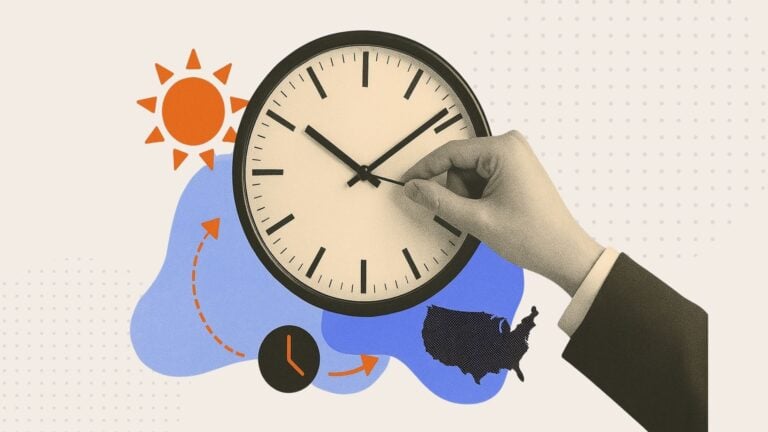Daylight Saving Time (DST) means it’s time to change the clocks and fall back or spring forward. Most of the US follows it, but not everyone’s a fan. Here’s what it means, how it started, and why some states want to stop doing it.
Twice a year, we all ask the same question: “Wait, when is Daylight Saving time again?” Maybe the sun is rising too early or setting suspiciously late. That’s when we know it’s time to change the clocks.
But why do we gain an hour in the fall and lose one in the spring? When did this start? And why are we still doing it?
What began as a way to make better use of daylight has now become a national debate in the US. Some states have already opted out, while others are trying to make daylight time permanent.
In this article, we break down how Daylight Saving works, why it exists, and how it affects things like work schedules and payroll. If you’ve ever wondered why you’re waking up so tired on a Monday in March, this one’s for you.
Key Takeaways
- Daylight Saving Time (DST) shifts clock forward in the spring and back in the fall.
- DST begins on the second Sunday of March and ends on the first Sunday of November.
- There is debate in the US about whether or not to make DST permanent or end it.
- DST impacts work life, affecting payroll, scheduling, and shifts.
What is Daylight Saving Time?
Daylight Saving Time (DST) helps make better use of natural daylight by shifting clocks forward one hour in the spring and back one hour in the fall. The goal is to have more daylight in the evening to reduce energy use (think: lightbulbs).
DST was originally introduced in the US during World War I as a way to save fuel, and returned during World War II. Not every state observed it, which led to confusion, especially in transportation and broadcasting schedules.
To address this, Congress passed the Uniform Time Act of 1966, which standardized the start and end dates of DST across the country, with the option for states to opt out.
Today, most states observe DST, except for Hawaii and most of Arizona (Navajo Nation observes DST within Arizona). The US Department of Transportation oversees time zones and DST observance, to ensure consistency for commerce and transportation.
When is Daylight Saving 2025?
Daylight Saving in 2025 starts on March 9 and ends on November 2.
In the US, Daylight Saving Time (DST) always starts on the second Sunday in March and ends on the first Sunday in November.
Every year, the clocks change at 2:00 AM, springing forward to 3:00 AM in March and falling back to 1:00 AM in November. That means you lose an hour of sleep in the spring and gain one back in the fall.
Which States Still Observe Daylight Saving Time?
Most US States still follow Daylight Saving Time, but 18 states have passed laws or resolutions to stay on it year-round. The issue? They need federal approval. Under the Uniform Time Act, states can only opt out of DST, but they can’t adopt it permanently without Congress.
Take a look at the map below to see which states observe Standard Time and which want to enact DST permanently.
US Time-Preference by State
Hover or click on a state to see its category.
The Benefits (and Drawbacks) of Daylight Saving Time
Daylight Saving Time affects millions of Americans twice a year, so it’s bound to spark debate. Some say it helps save energy and boosts business, while others point to health and sleep issues. Here’s what to consider:
Evening Daylight
- One of the main reasons DST exists is to give people more daylight in the evening. That extra hour of light after work or school can mean more time outside, which can boost business for retail and dining.
- The early morning is dark, which can be difficult for parents, students, and shift workers who can feel less alert. It can be disruptive to routine and lead to decreased productivity and higher rates of workplace accidents.
Energy Use
- DST was originally introduced to save energy by reducing the need for artificial light in the evening. The idea was that more daylight meant less electricity use, at least when homes were lit by gas or inefficient bulbs.
- Modern lighting (like LEDs) and efficient energy use for things like heating, cooling, and electronics make the savings less significant.
Traffic Safety
- Brighter evenings may reduce car accidents and pedestrian fatalities, since people are more visible in daylight.
- A 2020 study found that the spring switch to DST can temporarily increase fatal crash risk by 6%, especially in the morning. This spike is linked to sleep loss and body clock disruption, and typically fades after a week.
Sleep and Health
- Extended daylight hours can improve mood and potentially help with seasonal affective disorder.
- Switching the clocks disrupts our sleep cycles. The “spring forward” shift can lead to a loss of sleep, fatigue, and health issues like heart problems and workplace injuries.
What Daylight Saving Means for Work
Daylight Saving Time may seem like a small change, but it can impact your business operations more than you’d expect.
When the clocks shift, time tracking and payroll can suffer. In the spring, night shift workers might lose an hour of paid time when the clocks jump forward. The opposite happens in the fall, when a shift lasts an hour longer. If you don’t check your timesheets carefully, you could end up underpaying or overpaying your employees.
Scheduling can also take a hit. Employees might show up late, shifts could overlap, and teams in different locations or time zones can be unaligned. If you run a field or shift-based business, it takes extra effort to keep everyone on the same page (and schedule) when the clocks change.
Did You Know?
Connecteam’s scheduling app automatically adjusts scheduled shifts for Daylight Saving Time. No need to make manual changes or worry about payroll.
Remember: that one-hour shift can really throw people off, making them feel groggy and unfocused. In some jobs, that can increase the risk of accidents. As a business owner, patience, flexibility, and clear communication can go a long way during this transition.
Pro Tip
Use Connecteam’s free online team chat to keep everyone aligned before and after the clock change. Team instant messaging helps you communicate fast, so no one’s left guessing.
What’s Next for Daylight Saving Time?
Over the last few years, support has grown to end the biannual clock change. In 2022, the Senate unanimously passed the Sunshine Protection Act, which aims to make DST permanent nationwide. Currently, it’s stalled in the House, with no clear timeline for next steps.
Whether you’re for or against DST, it’s clear that it affects everything from health and energy use to employee schedules and payroll.
The best way to stay prepared is by using tools like Connecteam to help manage time, schedules, and team communication, so your business stays on track no matter changes lie ahead.
FAQs
Did the U.S. get rid of Daylight Saving time?
No, Daylight Saving time is still in effect across most of the U.S., except in states that have opted out like Hawaii and most of Arizona.
What states are getting rid of Daylight Saving time in 2025?
None officially. 18 states have passed laws to stay on DST year-round, but they need Congress’s approval before taking effect.
Are we losing Daylight Saving time?
Not yet, even though there’s growing support to end the clock changes.
Does the clock go back in November?
Yes, DST ends on the first Sunday in November, and the clocks fall back one hour at 2:00 AM.
Did Congress pass the Daylight Saving Time bill?
The Senate passed the Sunshine Protection Act in 2022, but the House hasn’t approved it yet.


